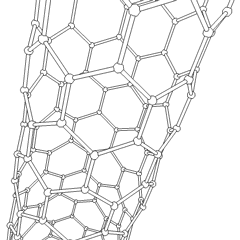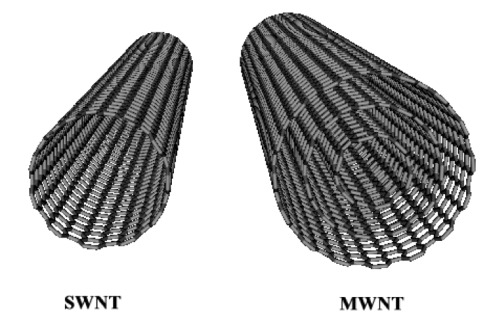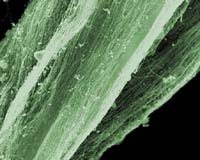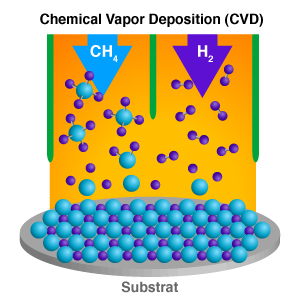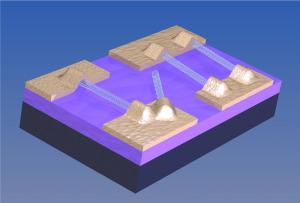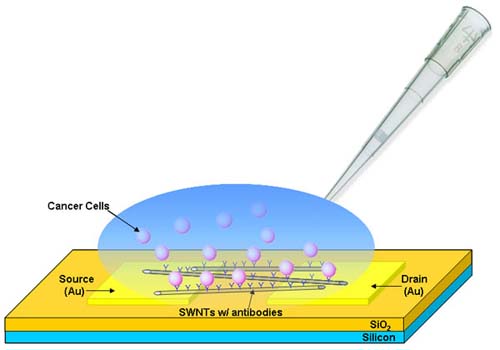|| INTRODUCTION || DISCOVERY || STRUCTURE || “SMART” CLOTHES ||
|| ELECTRICITY & POWER || CANCER & DISEASE TREATMENT || REFERENCES ||
—————————————————————————————————————–
Monthioux, Marc and Kuznetsov, Vladimir L. (2006). “Who should be given the credit for the discovery of carbon nanotubes?”. Carbon 44. doi:10.1016/j.carbon.2006.03.019. Retrieved on 4/15/08.
Oberlin, A. M. Endo, and T. Koyama, J. Cryst. Growth (March 1976). “Filamentous growth of carbon through benzene decomposition” 32: 335 – 349. doi:10.1016/0022-0248(76)90115-9. Retrieved on 4/15/08.
Baughman, R. H. (2000). Putting a new spin on carbon nanotubes. Science, 290(5495), 1310-1311.
Baughman, R. H., Zakhidov, A. A., & Heer, W. A. d. (2002). Carbon nanotubes: The route toward applications. Science, 297(5582), 787-792.
Chen, J., Hamon, M. A., Hu, H., Chen, Y., Rao, A. M., Eklund, P. C., et al. (1998). Solution properties of single-walled carbon nanotubes. Science, 282(5386), 95-98.
Collins, P. G., Arnold, M. S., & Phaedon Avouris. (2001). Engineering carbon nanotubes and nanotube circuits using electrical breakdown. Science, 292(5517), 706-709.
Dresselhaus, M. S., Dresselhaus, G., Charlier, J. C., & Hernández, E. (2004). Electronic, thermal and mechanical properties of carbon nanotubes. Philosophical Transactions: Mathematical, Physical and Engineering Sciences, 362(1823, Nanotechnology of Carbon and Related Materials), 2065-2098.
Endo, M., Hayashi, T., Kim, Y. A., Terrones, M., & Dresselhaus, M. S. (2004). Applications of carbon nanotubes in the twenty-first century. Philosophical Transactions: Mathematical, Physical and Engineering Sciences, 362(1823, Nanotechnology of Carbon and Related Materials), 2223-2238.
Gorman, J. (2001). Chemists decorate nanotubes for usefulness. Science News, 159(25), 390.
H. W. Kroto, J. R. Heath, S. C. O’Brien, R. F. Curl and R. E. Smalley (1985). “C60: Buckminsterfullerene”. Nature 318: 162 – 163. doi:10.1038/318162a0.
Iijima, Sumio (1991). “Helical microtubules of graphitic carbon”. Nature 354: 56 – 58.
Iijama, Sumio (1993). “Single-shell carbon nanotubes of 1-nm diameter”. Nature 363: 603 – 605.
Jonge, N. d., & Bonard, J. (2004). Carbon nanotube electron sources and applications. Philosophical Transactions: Mathematical, Physical and Engineering Sciences, 362(1823, Nanotechnology of Carbon and Related Materials), 2239-2266.
Kam, N. W. S., O’Connell, M., Wisdom, J. A., Dai, H., & Gray, H. B. (2005). Carbon nanotubes as multifunctional biological transporters and near-infrared agents for selective cancer cell destruction. Proceedings of the National Academy of Sciences of the United States of America, 102(33), 11600-11605.
Kasumov, A. Y., Deblock, R., Kociak, M., Reulet, B., Bouchiat, H., Khodos, I. I., et al. (1999). Supercurrents through single-walled carbon nanotubes. Science, 284(5419), 1508-1511.
May, M. (1999). Nanotechnology: Thinking small. Environmental Health Perspectives, 107(9), A450-A451.
Saito, S. (1997). Carbon nanotubes for next-generation electronics devices. Science, 278(5335), 77-78.
IMAGES CITED (URLs)
http://en.wikipedia.org/wiki/Carbon_nanotubes
http://en.wikipedia.org/wiki/Bucky_ball
nanocarb.meijo-u.ac.jp/
www.nsti.org/
www.new-england-contractor.com/
www.germes-online.com/
www.emergentarchitecture.com/
www.whatsnextnetwork.com/.

